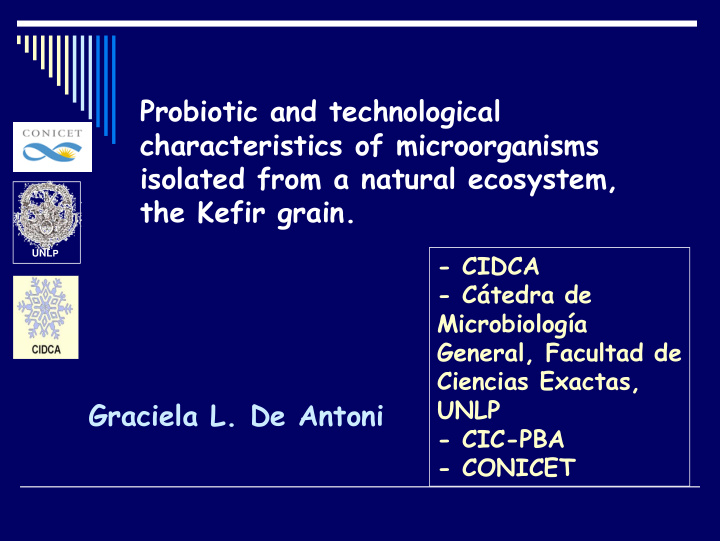



Probiotic and technological characteristics of microorganisms isolated from a natural ecosystem, the Kefir grain. - CIDCA UNL P - Cátedra de Microbiología General, Facultad de Ciencias Exactas, UNLP Graciela L. De Antoni - CIC-PBA - CONICET
Researchers: Analía Abraham Graciela Garrote Pablo Pérez María Serradell PHD students: Patricio de Urraza Emiliano Kakisu Marina Golowczyc Pablo Mobili UNL P Fernando Trejo Ayelén Hugo PHD students: Martin Humen Micaela Medrano Technicians: Lucia Brandi Judith Piermaría Mario Barrera Fernanda Hamet
Kefir Fermented milk from the Caucasian mountains Described as a food in: - Código Alimentario Argentino Art UNL P 576 - (Res. MSyAS N ° 295 del 14.04.99) - International Dairy Federation Bulletin
Kefir was use in * Treatment of gastrointestinal disorders * Treatment of respiratory disorders Kefir properties: UNL P - Antibacterial, antifungic and antitumoral ( in vitro and in animals) - Immunomodolatory (in animals ) Probiotic fermented milk
“ Kefir: a millenary fermented milk with probiotic properties ” Industrial production in east UNL P Europe and Asia Homemade: with grains
Kefir grains � Matrix polysaccharide-protein � Yeast � Lactic Acid Bacteria � Acetic Acid Bacteria 10 8 – 10 9 microorganisms/gram Acetobacter Lactobacillus UNL P Lactococcus Leuconostoc Saccharomyces Candida Source of Kluyveromyces strains safe and Torula potentially probiotic
Identification of isolates -Sugar fermentation - Whole-cell proteins by SDS-PAGE UNL P - Sequence of spacer 16S-23S rRNA - ARDRA - RAPD-PCR - FT-IR Dra. Liliana Semorile UNQ Dr. Osvaldo Yantorno CINDEFI
22 Heterofermentative Lactobacilli Lb. kefir Lb. parakefir Kefir grains 20 Homofermentative Lactobacilli Lb plantarum UNL P UNL P 40 yeasts 22 lactococci Kluyveromyces Lc. lactis subsp. lactis Saccharomyces Lc. lactis subsp. diacetylactis Selection of 5 strains resistant to gastrointestinal conditions : Lb. plantarum CIDCA 83114, Lb. kefir CIDCA 8348, Lc. lactis CIDCA 8221, Sc. cerevisiae CIDCA 8112, K. marxianus CIDCA 8154
Kluyveromyces marxianus CIDCA 8154 1- Glucose 2- Lactose 3- Milk (diluted 1:10) 4- Milk fermented with Lb. plantarum 83114 5- FM with yeast 8154 6- 83114 + 8154 (1: 1) 7- 83114 + 8154 (1: 3) 8- 83114 + 8154 (1: 5) 9- 83114 + 8154 (1: 8) 10- Commercial milk without lactose (diluted 1:10) UNL P 1 2 3 4 5 6 7 8 9 10 Thin layer chromatography (TLC) Sugar content (g/100ml) Milk fermented with ± DS* L. plantarum (48 hs) 3,91 ± 0,13 K. marxianus (48 hs) 0,07 ± 0,02 L. plantarum + K. marxianus (48 hs) 0,07 ± 0,01 Non fermented milk 4,03 ± 0,46 Comercial lactose-free milk 0,9
Bactericidal effect of SCS of Lb. plantarum against EHEC 71935 8 8318 7 Log 6 cfu/ml UNL P 5 8336 4 3 8338 2 1 83114 0 -1 0 5 time(h) Strain CIDCA 83114
SEM of Hep-2 monolayer incubated during 3 h with: UNL P EHEC 10 6 Control buffer Control Lb. plantarum 114 10 6
114 + EHEC 10 6 EHEC 10 6 UNL P EHEC 10 8 114 + EHEC 10 8
LDH liberated by Vero cells by EHEC SCS preincubated or not with Lb. plantarum CIDCA 83114 and their isolated walls 32 28 UNL P Porcentaje de LDH liberado 24 20 * 16 * 12 8 4 0
S-layer Lb. kefir S-layer UNL P S-layer: Hydrophobic protein 66-71 kDa S-layer protein in SCS: 0.1 mg/ml SDS-PAGE
Invation inhibition of Caco-2 cells by Salmonella preincubated with Lb. kefir SCS 5 10 Caco-2 Invasión de Salmonella sp (UFC/ml) 4 10 3 10 UNL P 2 10 Caco-2 + 1 Salmonella 10 0 10 Salmonella en PBS MRS # SN 8321 SN 83113 SN 8344 SN 8348 SN 8345 Caco-2 + Salmonella + S-layer
Invasion inhibition of Caco-2 by Salmonella preincubated with S-layer protein Salmonella (CFU/ml) * 4 10 * UNL P 3 10 l l l S m m m R / / / g g g M m m m A 1 5 1 A . 0 0 0 . . 0 0 S-layer protein was detected on Salmonella surface by Ag-Ac reaction
Adhesion of trophozoites of Giardia intestinalis WB on Caco-2 cells UNL P
In- -vivo assays vivo assays In Mouse C57BL/6 (S. lipolytica CIDCA 812, L. plantarum CIDCA 83114, L. kefir CIDCA 8348) 2,6 .10 7 Trofozoites per animal treatment UNL P control 2/20 8/20 Infection rate (7 2/20 8/20 days post-inoculation (10 %) (40 %) (10 %) (40 %) 1.10 4 6.10 3 Trofozoites/ml 1.10 6.10 4 3 Intestine content in infected animals
Spray drying: microorganismos del tricepa - Leche en polvo reconstituída al 11% - Temperaturas de salida: 70ºC - Temperatura de entrada: 180ºC - Presión: 5 Bar time (d) ASD 15 30 45 60 80 0 UNL P -1 -2 log (N/No) -3 -4 -5 -6 80 días a 6ºC el número de microorganismos viables : L. plantarum CIDCA 83114: 10 11 UFC/g L. kefir CIDCA 8348: 10 8 UFC/g S. cerevisiae CIDCA 82112: 10 6 UFC/g Dra. Paula Teixeira, Universidad Católica de Oporto
Muchas Gracias UNL P
Recommend
More recommend